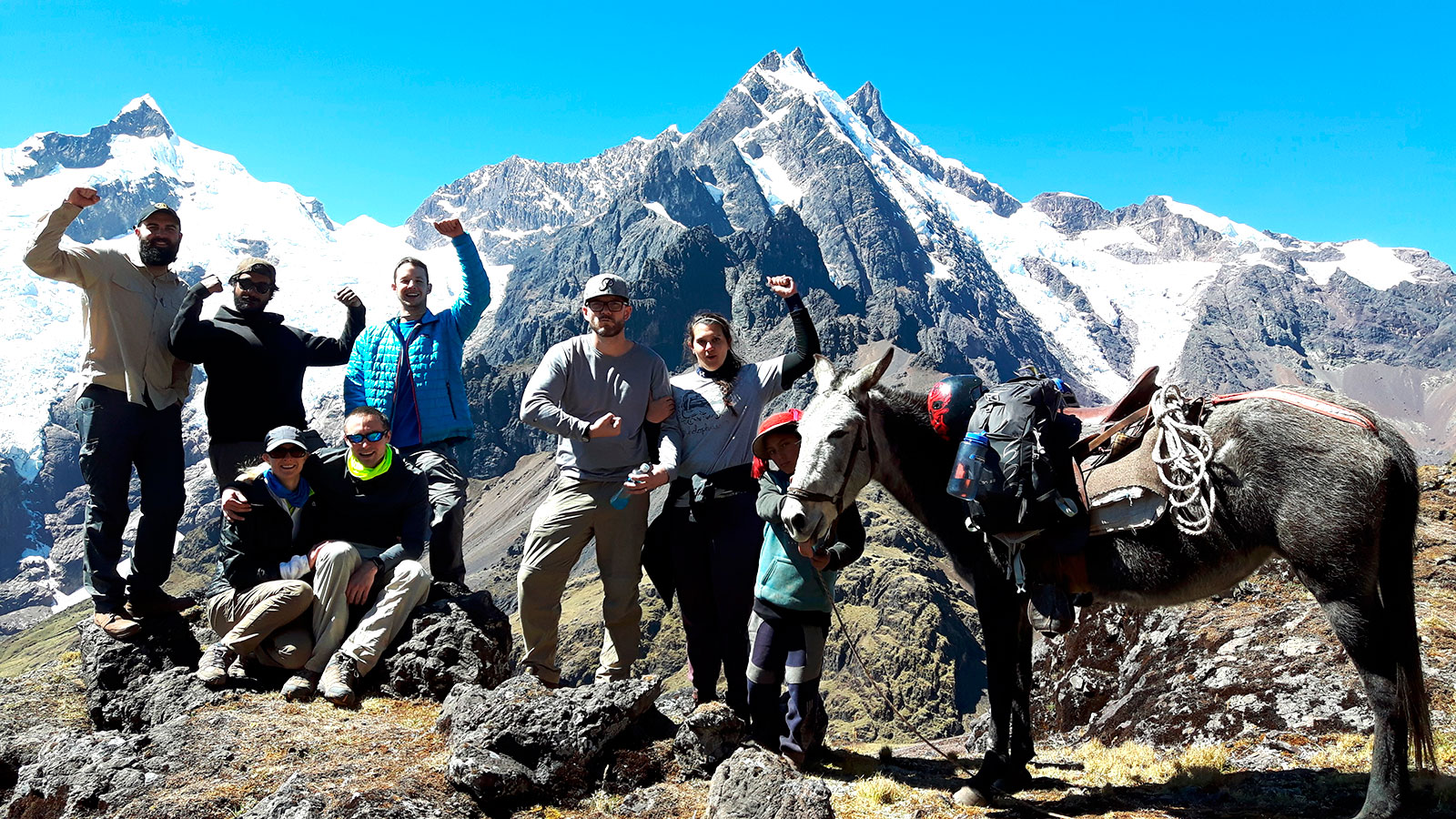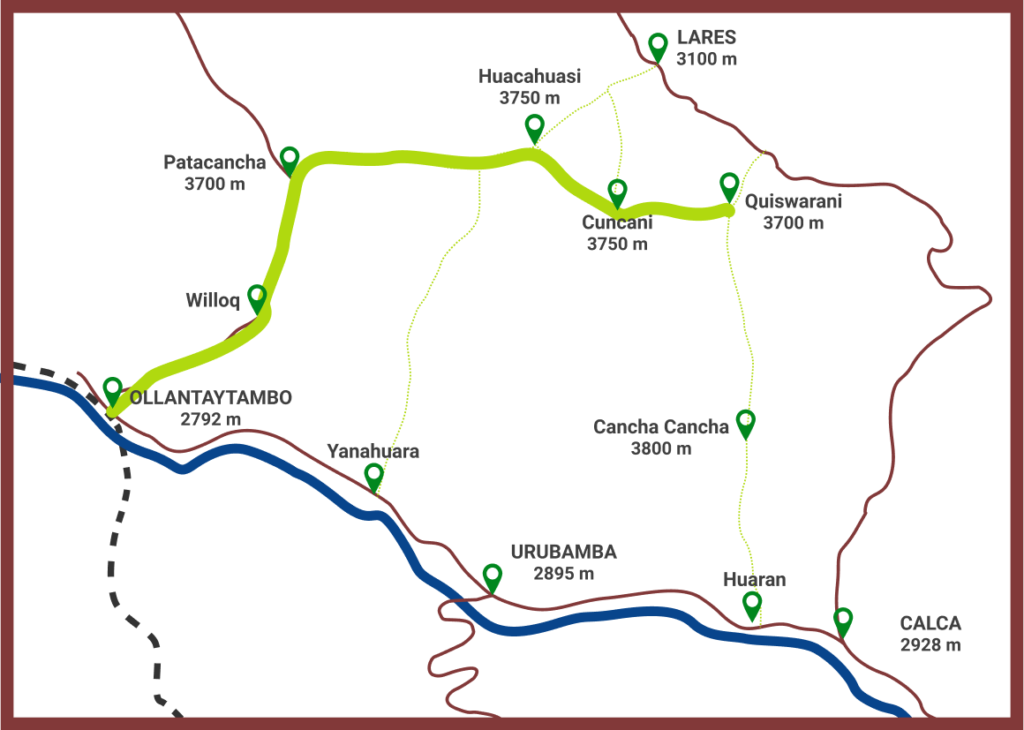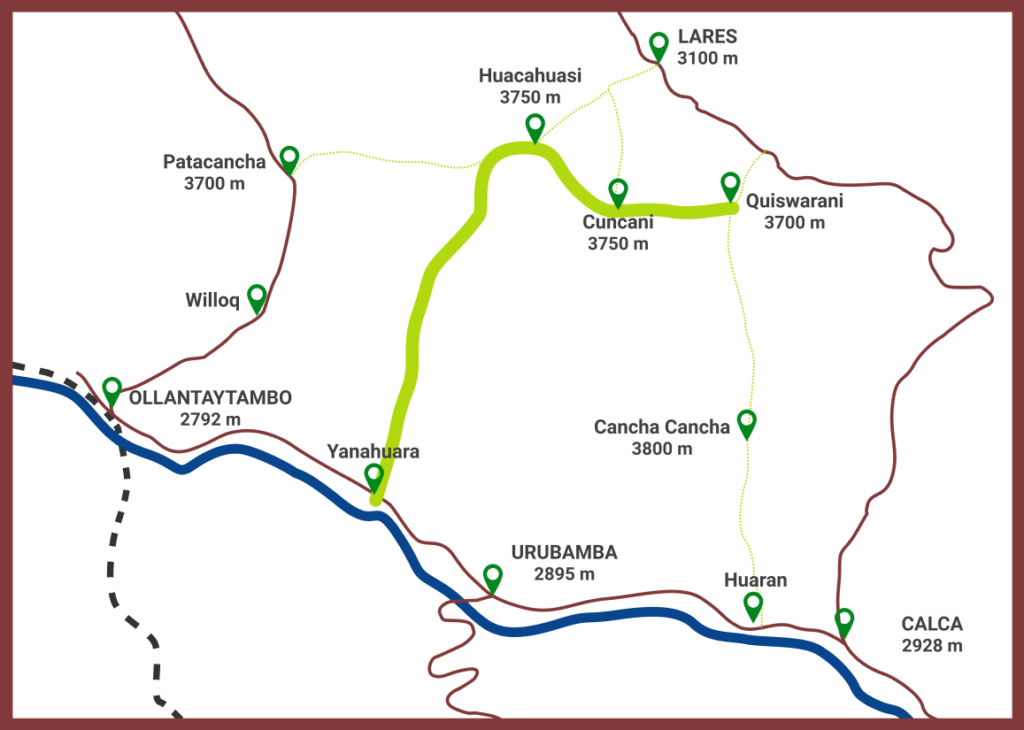Lares Trek to Machu Picchu | Ultimate Hiking Guide

Things to know before doing the Lares Trek in Cusco - Peru.
The Lares Trek To Machu Picchu In Peru is an incredible alternative to the Classic Inca Trail, offering a unique experience with the added bonus of visiting remote Andean villages. This trek provides an off-the-beaten-path adventure, ideal for those seeking a quieter and more culturally immersive journey. Best of all, no Lares Trek permits are required, making it a flexible and accessible choice for travelers.
Located to the east of the Urubamba Mountain Range, the Lares Trek crosses part of the Sacred Valley of the Incas, approximately 40 miles (64.37 km) north of Cusco and 35 miles (56.33 km) southeast of Machu Picchu. The trail showcases breathtaking scenery, from towering mountains to serene glacial lakes and lush valleys.
The trek can be completed in 3 or 4 days and is often combined with a visit to Machu Picchu, creating an unforgettable end to the journey. For those seeking a hybrid experience, the Lares Trek can also be paired with the Short Inca Trail, allowing trekkers to arrive at the Sun Gate (Inti Punku) in the afternoon for their first iconic views of Machu Picchu. This combined itinerary, which extends the adventure by 1 or 2 days, is becoming increasingly popular among hikers due to the limited availability of Inca Trail permits.
Altitude issues
As soon as travelers book their trip to Machu Picchu, especially with the multiple day hikes as Lares trek, they start wondering about altitude sickness.
The air at high altitude mountains contains less oxygen than sea level and forces your body to work harder to get the oxygen it needs. This can result in altitude sickness however, after many days at high altitude, your body will adjust to the lower quantity of oxygen within the air and you will feel fine.
With the altitude sickness, you may first feel like you have the flu or a hangover. You may have a headache, tiredness, loss of appetite, nausea or vomiting, dizziness, trouble sleeping and trouble breathing during exercise.
Most of the time, these symptoms will be mild. We always suggest easing into activity slowly, permitting your body to adjust. Drink plenty of fluids such as water or tea. Avoid drinking a lot of alcohol and coffee. They will cause you to go to the bathroom more often and become dehydrated. Avoid smoking as it makes it more difficult for your body to get oxygen. Avoid sleeping pills because they may cause shallow breathing at nighttime, making it tougher for your body to take in enough oxygen while you sleep.
Remember it is not a race. Do everything slowly.Even those who are very fit can suffer from altitude sickness if they race to the top of the mountain too quickly. Go slowly, it’ll provide your body with time to adjust to the altitude.
This is why we always recommend spending at least two days in Cusco before beginning any trek as such as the Inca Trail or the Salkantay / Ausangate / Lares / Choquequirao treks. If you have more time, even better. Cusco is an amazing city with a lot to do, so you won’t be bored.
These two days will be useful in acclimating and also, in case anything happens with your flight – delays or cancellations – it ensures you will be in the city on time for the start of your trek. This unfortunately does happen sometimes as there can be bad weather in the mountains and so it’s deemed too difficult to fly. Once you arrive in Cusco, it is best to spend the time not exerting yourself – relax, walk around the city center (it’s amazing), enjoy the Sacred Valley perhaps. We don’t suggest doing activities such as cycling, river rafting, horse riding, zip lining etc. because we have experienced people getting into accidents and then having to cancel their trek.
We also don’t suggest eating heavy meals or traditional foods before the trek, such as guinea pig, ceviche, bbq kebabs (‘anticuchos’) as you are not used to these kinds of foods at high altitudes. You can save them for after the trek. Drink plenty of water to stay hydrated.
Your healthcare provider may prescribe medicines, such as acetazolamide and dexamethasone, to help prevent altitude sickness. Start the drugs 2 days before you get to a high altitude and continue taking them while you are here.
Diamox is a very useful prescribed drug for adjusting to the altitude. If you haven’t spent much time in the mountains, we recommend asking your doctor for a prescription and beginning the medication 2 days before you come to Cusco. You want to take a lower dosage, either 125 mg twice a day or 250 mg once a day. Travel doctors know this, but some general practitioners aren’t familiar with the drug and prescribe 500 mg, but this is too much.
Insurance for Lares Trek, Salkantay, Inca trails to Machu Picchu
Tour operators insist that you have adequate insurance to cover any medical or accident-related expenses.
Make sure your insurance company knows of your travel plans and verify that your policy totally covers your trek and the other activities you plan. Specifically, for treks on the Inca Trail you require insurance coverage up to 4500 meters. For the Lares and Salkantay trails it is up to 5000 meters and for the Ausangate Trek up to 5500 meters.
It is your responsibility to ensure that you are fully and adequately insured for the duration of your trip. Please make sure that all activities, excursions and destinations in your itinerary are included in your travel insurance policy, in addition to your regular cover for cancellation and medical expenses.
There are recommended insurers such as Dogtag, the specialist adventure travel insurers, and the global supplier of travel insurance, World Nomads. Make sure you include hiking to your needed altitude as a sport/activity before purchasing and make certain to read the small print for any policy you’re considering. Different policies provide different levels of cover, so make sure you understand what is and isn’t included in your policy.
Keep a copy of your policy summary (containing policy number and the emergency contact number for your insurer) in your day pack at all times so that this information can be easily accessed should we need to contact the insurer on your behalf.
Lares Routes
The Lares mountains offer a number of trek routes to Machu Picchu, each showcasing a slightly different flavor of the Lares region. The most common Lares trek routes to Machu Picchu start at the thermal springs in Lares where one can take a quick dip before commencing the hike. All the trails can be completed as standalone treks without visiting Machu Picchu and do not require permits. As the routes are not maintained by the government, we try to do as much as we can, always bringing an extra porter just to help clean the trail from any trash other hikers leave behind. When we visit the village, we encourage the kids to take part by creating a competition to see who can collect the most trash with the winner receiving school supplies (they actually all get prizes but it makes a fun game!). In this way you get to spend time with the children, see how they live and what rural life is like in the Andes and that’s what makes this trek really special.
There are many Lares routes, but you will usually start by leaving Cusco (11,154ft, 3,400m) early on the first morning, typically around 05:00 and drive for 3.5 hours to the small town of Lares (10,334ft, 3,150m). Trekkers generally visit the thermal springs in Lares where you can take a quick dip before commencing your trek.
Route 1: Lares – huacawasi – Ipsaycocha – patacancha.
This route takes three days to trek (plus one extra day to visit Machu Picchu) and takes trekkers through two interesting Quechua weaving communities at Huacawasi and Patacancha, with a climb up and over the Ipsaycocha Pass (4,450m/14,600ft) on the second day. Patacancha is where the trek concludes on day three and from where you will travel by private transport to Ollantaytambo (2,792m/9,160ft), before catching the hour and 40-minute train to Aguas Calientes (2,040m/6,693ft), the town that sits below Machu Picchu, before visiting the Machu Picchu ruins the next day.
Walking distance: 8.7 miles/33 km
First Campsite: Huacahuasi 3,750 m/12,303ft (high) above sea level
Second Camsite: Ipsaycocha lake 3,900 m/12,795ftHighest Point: Ipsaycocha Pass 4,465 m/14,649ft

Route 2: Quishuarani – Cuncani – Ipsaycocha – Patacancha.
The route contains two very high passes. Leaving early on day one you will drive from Cusco to the Lares thermal springs, where you’ll stop for a break and can get breakfast / stock up on snacks and water. From there you’ll continue on to Quishuarani (12,139ft/3,700 m), arriving around 11:00 a.m.
The trek then starts with a gradual ascent that gets steeper as you approach the first pass, Huilquijasa (4,260m/13,976ft) and on day two the route continues up and over the Ipsaycocha Pass (4,450m/14,600ft).
Walking distance: 39 km
First Campsite: Cuncani 3,750m/12,303ft (high) above sea level
Second Campsite: Ipsaycocha lake 3,900m/12,795ft
Highest Point: Ipsaycocha Pass 4,465m/14,649ft

Route 3: Quishuarani – Cuncani – wacawasi – Yanahuara.
The Quishuarani to Yanahuara trek has the same first day as Route 2 but is better suited for more experienced trekkers as it is longer and more challenging (there are three passes over 4,200m that need to be crossed). The trail concludes in Yanahuara (2,873m/9,426ft).
Walking distance: 45 km
First Campsite: Cuncani 3,750m/12,303ft (high) above sea level
Second Campsite: Mantanay lake 3,900m/12,795ft
Highest Point: wacawasi Pass 4,560m/14,961ft

Route 4: Cuncani – Quishuarani – Cancha Cancha – Huaran.
You will drive from Cusco to Lares and after a quick dip in the thermal springs, you’ll continue on to Cuncani (3,700m/12,139ft). Starting in Cuncani village, the route goes over the Cuncani Pass (4,280m/14,042ft) to Quishuarani (3,700m/12,139ft) and then heads south crossing Pachacutec Pass (4,500m/14,763ft) and down to Cancha Cancha (3,800m/12,467ft), before continuing further down to the small town of Huaran (2,885m/9,465ft).
Walking distance: 40 km
First Campsite: Quishuarani 3,750m/12,139ft (high) above sea level
Second Campsite: Cancha Cancha 3,800m/12,467ft
Highest Point: Pachacutec Pass 4,500m/14,763ft

Route 5: Huaran – Cancha Cancha – Quiswarani – Lares – Ollantaytambo.
There is one simple reason why this Itinerary is the best Lares trekking route to Machu Picchu: You trek off the beaten track on our own route, passing through remote communities like Cancha Cancha and Quiswarani, where there is no modern technology. You will enjoy stunning waterfalls, lakes, llamas and alpacas and see many local weavers and farmers wearing colorful traditional clothing, and you might even get a chance to watch or partake in some weaving!
The area is famous for its handwoven textiles, so if you want to bring an authentic piece of Peru back home with you, then bring a few spare Soles. You can pick up a bargain whilst making a local weavers’ day!
After conquering the trek you’ll enjoy the natural thermal springs in Lares. The pools are divided ranging from freezing cold to very hot, they are all composed up of volcanic water, which is medicinal in nature and considered to be good for your joints, muscles, headaches and stress.
You will then take organized private transport to Ollantaytambo (2,790m/9,155ft), before the train journey about hour and 40-minute to Aguas Calientes town (2,041m/6,695ft), a town located below Machu Picchu. In order to visit Machu Picchu Incan site the next day.
An amazing alternative to the Inca Trail, with a climb up and over the Pachacutec Pass (4,500m/14,764ft) but slightly easier than the Salkantay trek, this trek lets you explore the Andes Mountains with a lot of opportunities to interact with local people in the Quechua communities.
Walking distance: 38 km
First Campsite: Cancha Cancha 3,800m/12,467ft(high) above sea level
Second Campsite: Qoalay lake 3,800m/12,467ft
Highest Point: Pachacuted Pass 4,500m/14,764

Lares Trek Weather
Regarding the weather for the lares trek to Machu Picchu, as in any mountain range, the weather is unpredictable and very changeable in the High Andes. It can rain during the dry season or be sunny and lovely during the rainy season – our motto is “Be prepared for everything”. We sometimes see four different seasons in one day!
Typically, the mornings are cool and the sun warms things up throughout the morning. The afternoons can be very warm. Dry season begins in April and goes through November. During rainy season it does not rain all the time. December, January and March can be very pleasant, with intermittent rain showers. Yes, it will probably rain a bit, but we are prepared for that and you will still have a great time. Our wettest month is February, when it does rain most days.
Layers are always good – being overly cold or hot is unpleasant. Bring rain gear and waterproof gloves – lots of people forget that. With layers, you can peel them off or add them as needed.
Packing List for Lares Trek - Trekking Checklist
- Original Passports and student cards (if applicable and booked as a student)
- Good backpack or day pack
- Good sleeping bag (can be rented in Cusco)
- Sleeping mat or inflatable sleeping pad (can be rented in Cusco)
- Good trekking shoes as the trail is muddy and slippery in some sections
- Walking sticks (can be rented in Cusco)
- Warm clothes (the temperature changes – you might experience 4 seasons all in one day)
- T-shirts (4), sun hat, 2 pairs of pants/trousers, gloves, 4 pairs of socks, rain jacket, warm jacket, extra layers
- Waterproof gloves (important!)
- Camera
- Sunscreen and sunglasses
- Insect repellent (non-malarial mosquitos)
- Rain poncho (you can buy this in Cusco or on the trek)
- Bathing suit
- Sandals (we recommend these to get changed into in the evenings)
- Scarf
- Water bottle (optional water tablets)
- Personal medical kit
- Flashlight
- Some plastic bags
- Toiletries: toilet paper, toothbrush, toothpaste, wipes, hand sanitizer
- Towel
- Gaiters (optional) – these sit over your trekking boot and lower leg and prevent mud, water, dust and grit from getting into your boots.
Lares or Salkantay - Lares vs Salkantay - Inca trail
Both the Lares and Salkantay Treks are the two most popular alternative treks to the Inca Trail and both have beautiful journeys. Salkantay is a slightly more difficult hike, but both have their challenges.
The Lares trek to Machu Picchu is amazing and has the special addition of visiting local rural villages. Most of the scenery is mountainous, at a higher altitude than the Inca Trail, and is really stunning. The village visits are very special and very genuine and the interactions with local children are usually a highlight for people. This hike includes an extra horse the entire trek for people to use if they are a bit tired of hiking. This is a nice addition for those worried about multi day hiking.
The Salkantay Trek is really all about the beauty of the Andes. You go deeper and higher into them and experience many micro-climates on the trek. You begin very high up in the mountains, higher than the Inca Trail, close to the snow-capped peaks and glaciers, and then you descend into high jungle full of lush flora and fauna. This trek also involves camping each night until the last night which you will spend in Aguas Calientes town, getting the bus up to the Machu Picchu ruins the following day. This hike is more challenging because the days are a bit longer which makes you more tired, and an extra horse is only available for the first day and a half.
The Inca trail trek allows you to visit archaeological remains every day and income is limited by the Peruvian government for 500 people per day due to the camping sizes. If your desire was to do the Inca trail and you did not get the permits, consider taking the lares trek plus short Inca trail to Machu Picchu.
The Lares Trek to Machu Picchu is 33 km (20.5miles) long.
We recommend that you bring a refillable water bottle as boiled water will be provided for free at breakfast, lunch, and dinner.
Our cooks prepare delicious high-energy meals that are appropriate for a trek of this duration. The menu usually includes pasta, rice, chicken, fresh fruit and vegetables, and breakfast foods like oatmeal, eggs, hot cereals and Vegetarian, vegan options.
